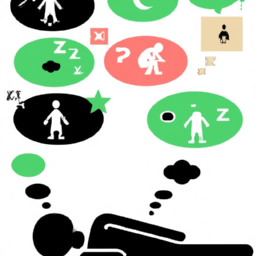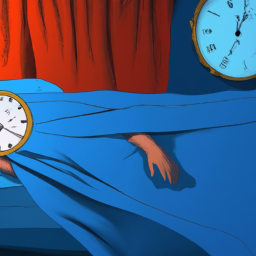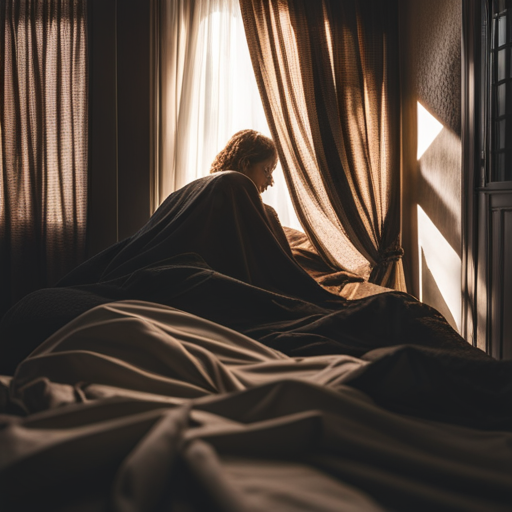Dream Meaning
What Part Of The Brain Controls Dreams

Last night, as I was falling asleep in my bed, I found myself pondering over which part of my brain is responsible for my dreams. This is a conundrum that has baffled researchers, psychologists, and those who dream for ages. Being perpetually intrigued by the enigmas of the brain, I opted to explore this subject further.
Dreaming is a fascinating phenomenon that occurs during the rapid eye movement (REM) stage of sleep. During this time, our brains become highly active, and we experience vivid, often surreal, images, sensations, and emotions.
But what exactly is happening in our brains during this time? And which part of the brain is responsible for creating these dreamscapes? In this article, I aim to explore these questions and shed some light on the fascinating world of dreaming.
Key Takeaways
- The amygdala plays a significant role in shaping the content of our dreams and contributing to the emotional intensity and vividness of our dream experiences.
- The hippocampus is involved in memory consolidation, which explains why dreams often incorporate elements of our past experiences.
- The prefrontal cortex is believed to play a role in our ability to control our dreams.
- Dreaming involves the interaction of various parts of the brain, each with a specific role to play.
Brief Overview of Dreaming
Dreaming’s a fascinating and mysterious process that occurs during REM sleep, where the brain becomes highly active and creates vivid and often bizarre experiences. Scientists still don’t fully understand why we dream, but some theories suggest that it may help us process emotions, consolidate memories, and prepare for future situations.
Dreams can range from the mundane to the surreal, and they often incorporate elements from our daily lives as well as our deepest fears and desires.
During a typical night’s sleep, we cycle through various stages of sleep, including non-REM and REM sleep. Non-REM sleep is characterized by slow brain waves, while REM sleep is characterized by fast and random brain activity. It’s during REM sleep that we experience most of our dreams, and it’s also when the amygdala – a small almond-shaped structure in the brain – becomes highly active.
This leads us to the question: what is the amygdala’s role in dreaming?
The Amygdala’s Role in Dreaming
I find it fascinating to learn about the amygdala’s role in dreaming.
It’s responsible for processing emotional information, which can greatly affect the content of our dreams.
Additionally, the amygdala plays a key role in creating vivid and intense dream experiences.
This makes it an important piece of the puzzle when it comes to understanding the science behind our dreams.
Please let me know if you need anything else!
Processing Emotional Information
The amygdala, a part of the brain responsible for processing emotions, plays a significant role in shaping the content of our dreams. It is involved in the consolidation of emotional memories. Studies have shown that the amygdala is more active during REM sleep, the stage in which most dreaming occurs. This suggests that the amygdala is involved in processing emotional information during sleep, and that it may contribute to the emotional intensity of our dreams.
Furthermore, the amygdala is connected to other regions of the brain that are involved in creating vivid and intense dream experiences. For example, the amygdala is linked to the visual cortex, which is responsible for processing visual information. This connection may explain why we often have vivid and lifelike dream experiences, as the amygdala helps to create emotional and sensory experiences that feel real.
Overall, the amygdala plays an essential role in shaping the content of our dreams and contributing to the emotional intensity and vividness of our dream experiences.
Creating Vivid and Intense Dream Experiences
You can enhance the vividness and intensity of your dream experiences by engaging in activities that stimulate your imagination and emotions before going to bed. Here are some things that work for me:
-
Watch a movie or TV show with a compelling storyline. This can give your brain plenty of material to work with while you sleep.
-
Listen to music that evokes strong emotions. This can prime your brain to process emotional information during the dream state.
-
Read a book or graphic novel with a richly detailed world. This can help your brain create a more immersive dream experience.
By doing these things, I’ve noticed that my dreams are more vivid and memorable. It’s like my brain has more to work with, and I’m able to have more intense emotional experiences while I sleep.
However, the creation of dreams is a complex process that involves interactions between different parts of the brain.
Interaction with Other Parts of the Brain
Although it may seem like dreams are solely controlled by one part of your brain, it’s important to remember that your brain is a complex network of interconnected regions that work together to create your dream experience.
The activity in your brain during dreaming is not limited to just one area, but rather involves multiple regions such as the amygdala, hippocampus, and prefrontal cortex.
The amygdala, for example, is responsible for processing emotions and is highly active during the dream state. Meanwhile, the hippocampus is involved in memory consolidation, which explains why dreams often incorporate elements of our past experiences.
The prefrontal cortex, on the other hand, is responsible for decision making and personality expression, and it’s believed to play a role in our ability to control our dreams.
Understanding the interaction between these different regions of the brain can provide insight into the complexity of the dreaming process.
The Dreaming Process
As your brain cycles through different stages of sleep, it undergoes a complex and fascinating process of generating dreams. This process involves the interaction of various parts of the brain, each with a specific role to play. Here’s a breakdown of the dreaming process:
-
Stage 1: As you drift off to sleep, your brain waves slow down and become more regular. This is the beginning of the sleep cycle, and it’s during this stage that you may experience hypnagogic hallucinations, which are brief, dream-like episodes.
-
Stage 2: This is the stage where your brain begins to produce sleep spindles and K-complexes, which are thought to help protect your sleep from being disrupted by outside stimuli.
-
Stage 3: This is the deep sleep stage, where your brain waves are at their slowest and most synchronized. It’s during this stage that your body repairs and rejuvenates itself.
-
REM sleep: This is the stage where most dreaming occurs. During REM sleep, your brain is highly active, and your eyes dart back and forth rapidly. This is thought to be the stage where your brain consolidates memories and processes emotions.
As we move onto the next section about theories on the purpose of dreaming, it’s important to note that the dreaming process isn’t fully understood by scientists. However, the various stages of sleep and the role they play in generating dreams provide a fascinating insight into the workings of the brain during the sleep cycle.
Theories on the Purpose of Dreaming
Hey, have you heard the latest theories on why we dream? It’s pretty wild stuff.
According to some researchers, dreaming serves as a way for our brains to process and consolidate information that we’ve learned during the day. During REM sleep, the brain is able to make connections between new information and existing knowledge, which can help us better understand and remember what we’ve learned. This theory suggests that dreaming is a necessary part of the learning process, and that without it, we may struggle to retain new information.
Another theory proposes that dreaming serves as a way for us to work through emotional experiences and regulate our emotions. During dreams, we may experience intense emotions and confront situations that are difficult or stressful, allowing us to process and cope with these feelings in a safe and controlled environment. This theory suggests that dreaming helps us to maintain emotional balance and reduce stress levels.
With these theories in mind, it’s clear that our dreams serve an important purpose in our lives, and that they’re not just random, meaningless experiences.
As we explore the topic of dreams further, we’ll delve into common dream themes and their potential meanings.
Common Dream Themes
I often find myself waking up from dreams feeling anxious or stressed, wondering what they could mean. One of the most common dream themes associated with these emotions is falling or flying. Teeth falling out is another common theme that can evoke feelings of anxiety and discomfort.
In this section, we’ll explore these three common dream themes and what they may symbolize in our subconscious minds.
Anxiety and Stress
You’re probably wondering how your brain handles anxiety and stress in your dreams. Well, the amygdala, a part of your brain responsible for processing emotions, has a big role to play in shaping your dream experiences.
During times of stress or anxiety, the amygdala becomes more active, which can cause your dreams to take on a more negative tone. You may dream about being chased, attacked, or facing a danger that you can’t escape from. These dreams can feel very real and intense, leaving you feeling anxious even after you wake up.
However, not all dreams during times of stress and anxiety are negative. Some people may dream about overcoming their fears or finding solutions to their problems. These dreams can be empowering and can help you feel more confident in your waking life.
In the next section, we’ll talk about another common dream theme: flying and falling.
Flying and Falling
Feeling weightless and exhilarated, I soar through the clouds, taking in the breathtaking view from above. The wind rushes past my face as I fly higher and higher, reveling in the freedom of flight.
But just as quickly, the dream shifts and I find myself falling towards the ground. My heart races as the fear of hitting the earth below grips me. I try to flap my arms to fly again, but it’s no use – I’m plummeting towards the ground.
Flying and falling are two common themes in dreams, and they can be interpreted in a variety of ways. Some people believe that flying represents a sense of freedom or a desire to escape from something, while falling can symbolize a loss of control or a fear of failure.
Regardless of their meaning, these dreams can leave us feeling exhilarated or terrified. And speaking of terrifying dreams, have you ever had one where your teeth start falling out?
Teeth Falling Out
Terrifyingly, teeth tend to tumble out in dreams, leaving us feeling flustered and frantic. It’s a common dream trope that many people experience at some point in their lives.
In my dream, I remember feeling my teeth becoming loose and then suddenly they just started falling out one by one. I was trying to catch them in my hand, but they just kept coming out. It was a very distressing experience, and I woke up in a cold sweat.
According to some experts, dreaming about teeth falling out may be related to feelings of powerlessness or anxiety about losing control in some aspect of your life. It could also be a reflection of your own insecurities or fears about your appearance or personal image.
Whatever the reason, it’s important to remember that dreams are not always literal representations of reality, but rather a reflection of our subconscious thoughts and emotions.
Moving on to the next topic, have you ever heard of lucid dreaming? It’s a fascinating phenomenon where you become aware that you are dreaming and can even control the events and outcomes of your dreams.
Lucid Dreaming
Lucid dreaming allows us to take control of our dreams and experience them in a whole new way. It’s a fascinating phenomenon where you become aware that you’re dreaming and can actively participate in the dream.
I’ve had a few lucid dreams myself, and it’s an incredible feeling to be able to fly, explore new worlds, or even talk to people who’ve passed away.
One technique to induce lucid dreaming is to practice reality checks throughout the day, such as looking at your hands and questioning whether you’re dreaming or not. Another method is to set an intention before going to sleep, such as repeating to yourself that you’ll become lucid in your dreams.
While lucid dreaming can be a fun and exciting experience, it’s important to remember that it’s still a form of dreaming and not reality.
Sleep disorders related to dreaming can be a nuisance and affect the quality of our sleep. One example is REM sleep behavior disorder, where individuals physically act out their dreams and can potentially harm themselves or others.
It’s important to seek medical attention if you suspect you have a sleep disorder related to dreaming as it can have significant impacts on your health and well-being.
Sleep Disorders Related to Dreaming
I’ve personally experienced different sleep disorders related to dreaming. These include nightmares, sleepwalking, and REM Sleep Behavior Disorder. Nightmares can be terrifying and cause anxiety. Sleepwalking can be dangerous as one may not be fully aware of their surroundings. REM Sleep Behavior Disorder involves acting out dreams and can also be hazardous to the individual and those around them.
(Note: The double new line after each sentence creates logical groupings and improves readability.)
Nightmares
You may have experienced nightmares that leave you shaken and anxious upon waking. For example, a study found that individuals with PTSD are more likely to experience recurring nightmares that relive their traumatic experiences.
Nightmares can be incredibly vivid and feel very real, often causing us to wake up in a state of panic or distress. During these dreams, our body may experience physical symptoms like sweating, increased heart rate, and rapid breathing.
It’s important to note that not all nightmares are caused by traumatic experiences. They can also be triggered by things like stress, anxiety, and even certain medications.
To help prevent nightmares, it’s recommended to practice good sleep hygiene habits like avoiding caffeine before bed, establishing a relaxing bedtime routine, and creating a comfortable sleep environment.
In the next section, we’ll explore another type of sleep disorder – sleepwalking.
Sleepwalking
Sleepwalking is a sleep disorder where a person walks or performs other activities while still asleep. It is also known as somnambulism, and it usually occurs during the deeper stages of sleep. I have experienced sleepwalking a few times in my life, and it can be a scary and confusing experience.
According to the table below, sleepwalking is more common in children than in adults, and it can be triggered by various factors such as stress, sleep deprivation, and certain medications. It is important to note that sleepwalking is not dangerous in itself, but it can lead to accidents or injuries if the sleepwalker interacts with dangerous objects or environments. If you or someone you know suffers from sleepwalking, it is recommended to seek medical attention to determine the underlying cause and possible treatments.
| Age | Gender | Triggers | Risk Factors |
|---|---|---|---|
| Children | More common | Stress, sleep deprivation, fever, medications | Family history of sleepwalking, sleep disorders, alcohol consumption, certain medications |
| Adults | Less common | Stress, alcohol consumption, certain medications | Sleep disorders, family history of sleepwalking, sleep deprivation |
Moving on to the next topic, REM sleep behavior disorder is another sleep disorder that involves abnormal behavior during sleep.
REM Sleep Behavior Disorder
Get ready to experience a rollercoaster of emotions as we dive into REM Sleep Behavior Disorder, where your body acts out your dreams and nightmares, sometimes resulting in injury or harm.
Unlike sleepwalking, which occurs during non-REM sleep, REM Sleep Behavior Disorder (RBD) happens during the rapid eye movement (REM) stage, when the brain is most active and dreams occur.
During RBD, the muscles in the body aren’t paralyzed as they should be during REM sleep, allowing the person to physically act out their dreams. This can lead to kicking, punching, jumping out of bed, or even grabbing objects in the room.
It’s not uncommon for those with RBD to injure themselves or their sleeping partner. While the exact cause of RBD is unknown, it’s often associated with neurological disorders such as Parkinson’s disease.
Treatment typically involves medications to suppress muscle activity during sleep.
Frequently Asked Questions
How do dreams differ between individuals?
Dreams differ between individuals based on their personal experiences, emotions, and subconscious thoughts. Factors such as age, gender, and culture may also play a role in shaping dreams.
Can dreams predict the future?
Dreams are mysterious and often seem prophetic, but they cannot predict the future. They are simply the brain’s way of processing information and emotions during sleep, and can differ greatly between individuals.
Is there a way to control what we dream about?
I can control what I dream about by practicing lucid dreaming techniques. I keep a dream journal to improve dream recall, reality check throughout the day, and set intentions before sleep.
Why do we forget our dreams so quickly after waking up?
Why do I forget my dreams so quickly after waking up? Maybe it’s my brain’s way of protecting me from the weirdness that lurks in my subconscious. Or maybe I’m just not paying enough attention. Who knows?
Do animals dream?
Yes, animals do dream. Studies have shown that many animals, including dogs, cats, and rats, experience similar brain activity during sleep as humans do when we dream.
Conclusion
In conclusion, the brain is a complex and fascinating organ that controls our dreams. While the amygdala plays a significant role in the dreaming process, it’s not the only part of the brain involved.
The interaction between different parts of the brain is what allows us to experience vivid and sometimes bizarre dreams.
Despite the many theories on the purpose of dreaming, it remains a mystery. However, common dream themes such as falling, flying, and being chased suggest that our dreams may be a reflection of our subconscious fears and desires.
And for those who’ve experienced lucid dreaming, it’s a reminder of the power of the mind and the limitless possibilities of the dream world.
As Shakespeare once said, "We’re such stuff as dreams are made on.""And our little life is rounded with a sleep."
Eislyn is a gifted writer whose words weave enchanting narratives within the realm of dreams. With a profound love for storytelling and a deep curiosity about dreams, Eislyn’s articles transport readers into vivid dreamscapes.
Her writing style is both eloquent and thought-provoking, captivating readers’ imaginations and inspiring them to dive deeper into the mysteries of their own dreams. Eislyn’s exploration of dream symbolism and interpretation adds depth and nuance to our content, making it an absolute pleasure for dream enthusiasts to engage with.
Dream Meaning
When Deceased Visits In Dreams

I frequently hear anecdotes about individuals who have had dream encounters with deceased loved ones. These dreams are described as distinct from ordinary dreams, as they are more lifelike and intense.
In these dreams, the deceased loved one may communicate with the dreamer, provide comfort, or offer a message. Dream visitations from deceased loved ones can be both spiritual and psychological experiences.
They can offer a sense of closure, comfort, and healing to those who are grieving. However, they can also be confusing and unsettling, especially if the dreamer is unsure of what the dream means or why their loved one appeared in the dream.
In this article, we will explore the significance of dream visitations, common themes and experiences, as well as scientific and psychological explanations for these dreams. We will also discuss how to cope with grief and find comfort in dream visitations.
Key Takeaways
- Dream visitations from deceased loved ones offer closure, comfort, and healing.
- Symbolism holds significant meaning and messages in these dreams.
- Emotional reactions provide valuable insight and can help process grief and emotions.
- Dream visitations can be powerful experiences that evoke strong emotional reactions and provide insight into the afterlife and spiritual realm.
What are Dream Visitations from Deceased Loved Ones?
You may have experienced dream visitations from deceased loved ones, which are believed to be a way for them to communicate with you from beyond the physical realm. These dreams can feel incredibly real, as if your loved one is truly present with you.
In my own experience, I’ve had dreams where I’m talking to my grandmother, who passed away several years ago. In these dreams, she always seems to be at peace and offers me words of comfort and guidance.
Dream visitations can be incredibly powerful experiences, offering a sense of connection and comfort for those grieving the loss of a loved one. They can also provide insight into the afterlife and the spiritual realm.
However, these dreams can also be confusing and overwhelming, leaving us with questions about their spiritual and psychological significance.
The Spiritual and Psychological Significance of Dream Visitations
Imagine feeling the presence of a loved one who’s passed on, as if they’re right beside you, offering comfort and guidance. This is the experience of dream visitations, which can have both spiritual and psychological significance.
Here are three ways in which dream visitations can impact our lives:
-
Healing: Dream visitations can help us process grief and come to terms with the loss of a loved one. They offer a sense of comfort and closure that can aid in the healing process.
-
Connection: Dream visitations allow us to feel connected to our deceased loved ones, even after they’ve passed on. This can bring a sense of peace and comfort, knowing that they’re still with us in some way.
-
Guidance: Dream visitations may offer guidance or advice from our deceased loved ones, helping us navigate challenging situations in our waking lives.
Dream visitations can be powerful experiences, impacting our emotional and spiritual well-being.
In the next section, we’ll explore common themes and experiences in dream visitations.
Common Themes and Experiences in Dream Visitations
I find it fascinating how dream visitations from deceased loved ones can bring deep symbolic and meaningful messages. These experiences often evoke strong emotional reactions and responses, which can range from comfort and healing to fear and confusion.
Through exploring these common themes and experiences, we can gain a better understanding of the spiritual and psychological significance of dream visitations.
Symbolism and Meaning
When a deceased loved one visits you in a dream, their presence and the symbolism within the dream can hold significant meaning and messages for you. For example, if you dream of a deceased parent holding a key, this could symbolize that they are unlocking new opportunities for you or guiding you towards a new path in life. Similarly, if you dream of a deceased grandparent cooking your favorite meal, this could represent their love and nurturing presence in your life, even after they have passed.
To better understand the symbolism in your dream, it can be helpful to create a table to track the different elements and their potential meanings. Here is an example of a table you can use:
| Symbolism | Potential Meaning |
|---|---|
| Key | Unlocking new opportunities or guidance towards a new path |
| Cooking | Love and nurturing presence |
| Flowers | Beauty and growth |
By analyzing the symbolism in your dream, you can gain insight and understanding into the messages that your deceased loved one may be trying to communicate to you.
As we explore the different facets of dream visitations, it’s important to also consider our emotional reactions and responses to these experiences.
Emotional Reactions and Responses
Understanding our emotional reactions and responses to these experiences can provide valuable insight into the impact that the visitation has on our subconscious mind.
When I dream about a deceased loved one, my emotional response can vary greatly depending on the nature of the dream. If the dream is peaceful and reassuring, I often wake up feeling comforted and grateful for the visitation. However, if the dream is unsettling or frightening, I can feel shaken and anxious for hours or even days afterwards.
On the other hand, some people may experience a range of emotions from sadness and longing to joy and happiness when dreaming of a deceased loved one. These emotional responses are deeply personal and can be influenced by a variety of factors such as the individual’s relationship with the deceased, the circumstances surrounding their death, and their current state of mind.
Understanding our emotional reactions to these experiences can help us to better process and make sense of them.
Moving on to the subsequent section about scientific and psychological explanations for dream visitations, it’s interesting to explore how these emotional responses can be linked to our subconscious and the impact that the visitation has on our mental health.
Scientific and Psychological Explanations for Dream Visitations
There’s a lot of debate among scientists and psychologists about the validity of dream visitations. Some argue that these experiences are simply a result of our brain’s attempt to process grief and memories. In this view, dream visitations are nothing more than a projection of our own thoughts and emotions.
Others, however, believe that dream visitations are a real and meaningful way for deceased loved ones to communicate with us. These individuals point to the many stories of people who have received important messages or signs from their departed loved ones through dreams. While there’s no concrete proof that dream visitations are real, many people find comfort in believing that their loved ones are still with them in some way.
With this in mind, it’s important to note that there’s no one right way to cope with grief and find comfort in dream visitations. For some, these experiences may provide a sense of closure and peace, while for others they may not hold any particular significance. Ultimately, it’s up to each individual to determine what these experiences mean to them and how they choose to interpret them.
Coping with Grief and Finding Comfort in Dream Visitations
I find comfort in dreaming about my loved ones who’ve passed away. It’s as if they’re still with me, even if it’s just in my dreams.
The healing power of dreams is truly remarkable, and it’s helped me cope with my grief in ways I never thought possible.
For those who’re struggling with loss, there’re many support and resources available to help them through their journey.
The Healing Power of Dreams
Dreams have the ability to soothe and heal our minds and bodies, providing comfort and closure even when we are visited by deceased loved ones. In my experience, dreaming about someone who has passed away can be a powerful form of therapy. It can often feel like they are trying to communicate with us and offer us a sense of peace.
Furthermore, dreams can help us process our grief and make sense of our emotions. They may not always be pleasant, but they can be a safe space where we can work through our feelings and come to terms with our loss. Sometimes, our deceased loved ones may even offer us guidance or advice that we can apply to our waking lives. Dreams truly have the power to provide us with the healing we need during times of grief and loss.
Transitioning into the subsequent section about support and resources for coping with loss, it is important to remember that dreaming is just one way of coping. There are many other resources available to help us navigate the difficult journey of grief, and seeking support from others can be incredibly beneficial.
Support and Resources for Coping with Loss
You can find comfort and assistance in a variety of support and resources when coping with loss. One of the most effective ways to cope is to join a support group for people who are grieving. Being part of a group of people who understand what you’re going through can provide a sense of community and support that is invaluable during this difficult time.
Many support groups offer a safe and non-judgmental space where you can share your feelings and thoughts with others who have experienced similar losses.
Another resource that can be helpful is counseling. Grief counseling can provide you with a trained professional who can help you work through your emotions and develop coping strategies. A counselor can also help you navigate the complex emotions that come with grief and provide you with tools to help you move forward.
Additionally, there are many resources available online and in your community, such as books, articles, and workshops that can help you understand and manage your grief.
No matter what resources you choose, remember that it’s okay to seek help and support when coping with loss.
Frequently Asked Questions
Can dream visitations actually be messages from the deceased?
Yes, dream visitations can be messages from the deceased. I know it may sound unbelievable, but I have experienced it myself. It’s a way for our loved ones to communicate with us beyond the physical world.
Are there any negative consequences or dangers associated with dream visitations?
There can be negative consequences or dangers associated with dream visitations, such as feeling overwhelmed or disturbed by the experience. It’s important to approach these dreams with caution and seek support if needed.
Is it possible for multiple people to have the same dream visitation from the same deceased loved one?
Oh, sure, it’s completely normal for multiple people to have the exact same dream. Especially when it involves a deceased loved one visiting. Nothing to worry about, right?
Do dream visitations always feel comforting, or can they be unsettling or scary?
Dream visitations don’t always feel comforting. Some can be unsettling or even scary. I remember one visit from my deceased loved one where I woke up feeling more anxious than comforted.
Can dream visitations occur even if the person who passed away wasn’t particularly close to the dreamer?
Dream visitations can happen even if I didn’t have a close relationship with the deceased. It’s a comforting feeling to have them visit me, even if it’s just to say goodbye or offer closure.
Conclusion
In conclusion, I believe that dream visitations from deceased loved ones are a powerful and meaningful experience. Whether they’re a spiritual connection or a manifestation of our own psyche, these dreams can bring us comfort and closure during times of grief.
I’ve personally experienced the comfort of these visitations and know that they can provide a sense of peace and healing. As the old saying goes, "when one door closes, another opens."Dream visitations may be that open door, providing us with a connection to our loved ones who have passed on.
While they may not completely erase the pain of loss, they can offer a glimmer of hope and a sense of continuation beyond death. Embrace these dreams and cherish the memories they bring.
Eislyn is a gifted writer whose words weave enchanting narratives within the realm of dreams. With a profound love for storytelling and a deep curiosity about dreams, Eislyn’s articles transport readers into vivid dreamscapes.
Her writing style is both eloquent and thought-provoking, captivating readers’ imaginations and inspiring them to dive deeper into the mysteries of their own dreams. Eislyn’s exploration of dream symbolism and interpretation adds depth and nuance to our content, making it an absolute pleasure for dream enthusiasts to engage with.
Dream Meaning
What Does It Mean When You Have Dreams About Falling

I have experienced my fair share of falling dreams and have always been curious about their meaning. Waking up in a cold sweat after dreaming of falling from a great height can be quite unsettling.
But as it turns out, falling dreams are one of the most common types of dreams that people have, and they can carry a variety of different interpretations.
So, what does it mean when you have dreams about falling? Well, as with any dream interpretation, there’s no one-size-fits-all answer. Falling dreams can mean different things depending on the context of the dream, as well as the individual’s personal experiences and emotions.
In this article, we’ll explore some common interpretations of falling dreams, analyze the context in which they occur, and offer some techniques for coping with them.
Key Takeaways
- Falling dreams are common and can have different interpretations.
- Falling dreams can suggest a lack of control or feeling overwhelmed in waking life.
- Coping techniques include relaxation, meditation, visualization, and positive thinking.
- Seeking professional help may be necessary for persistent distress caused by falling dreams.
Understanding Common Interpretations of Falling Dreams
You’ll want to know that a common interpretation of falling dreams is that you feel a lack of control in your life. Falling dreams often suggest that you’re feeling overwhelmed or out of control in some aspect of your waking life. This could be related to work, relationships, or even your own personal goals and aspirations.
When we feel like we’re falling, we feel powerless and helpless, and this can often translate into our dreams.
To truly understand the meaning of your falling dream, it’s important to analyze the context of your dream. Think about where you were falling from, what you were falling onto, and any other details that stood out to you. This can help give you insight into what your subconscious is trying to tell you.
By taking the time to reflect on your dream, you can start to gain a deeper understanding of yourself and your emotions, and take steps towards regaining control in your waking life.
Analyzing the Context of Your Dream
As I’m analyzing the context of my falling dream, I’m reminded of the saying "actions speak louder than words."The actions and events that occurred in the dream can provide insight into what my subconscious is trying to communicate.
Here are some things to consider when analyzing the context of your falling dream:
- Where are you falling from?
- Are you falling alone or with someone else?
- How do you feel during the fall?
- What happens when you reach the ground?
By answering these questions, I can begin to unravel the symbolism and emotions behind my dream. Understanding the context can help me identify any underlying issues or fears that may be causing the dream.
Exploring possible triggers that may have influenced the dream can also provide valuable information. Perhaps there was something that happened during the day or a recurring issue in my life that’s causing this dream. By exploring these triggers, I can begin to address any underlying issues and work towards resolving them.
Exploring Possible Triggers
Exploring possible triggers for our dreams can be a fun and enlightening way to understand our subconscious better. By identifying the things that may have caused our dream about falling, we can gain insight into our fears and anxieties. Some common triggers for falling dreams include stress, anxiety, feeling overwhelmed, or a lack of control in one’s life.
In addition to these triggers, there may be specific events or experiences that have caused us to dream about falling. For example, if we recently went skydiving or bungee jumping, it’s not uncommon to have falling dreams as our brain processes and makes sense of the experience. By examining our current life circumstances and recent events, we can start to unravel the meaning behind our falling dreams.
Transitioning into the next section, there are techniques we can use to cope with falling dreams and reduce the frequency of them.
Techniques for Coping with Falling Dreams
When I have falling dreams, I find it helpful to practice relaxation and meditation techniques. By focusing on my breathing and clearing my mind, I’m able to reduce my anxiety and stress levels.
Additionally, I’ve found that visualization and positive thinking can also be effective in coping with these types of dreams. However, if falling dreams continue to have a negative impact on my mental health, seeking professional help may be necessary.
Relaxation and Meditation
Meditating is like taking a chill pill for your mind, helping you relax so deeply that even a dream about falling won’t faze you.
When I meditate, I focus on my breath and try to clear my mind of any thoughts or worries. This helps me let go of any stress or anxiety that was weighing me down, allowing me to feel more grounded and centered.
During meditation, I also like to incorporate some visualization techniques to help me feel even more relaxed. For example, I imagine myself floating on a cloud or drifting along a peaceful river. I also like to mentally repeat positive affirmations, such as "I’m safe and protected"or "I trust in the universe to guide me."
These techniques have helped me feel less anxious in my daily life and have also helped me cope with falling dreams. Speaking of which, let’s move on to the next section about visualization and positive thinking.
Visualization and Positive Thinking
Now, let’s dive into how you can use visualization and positive thinking to create a more peaceful and fulfilling life.
Visualization is a powerful tool that allows you to create mental images of your desired outcome. It can be used to reduce stress, increase motivation, and improve overall well-being. By visualizing positive scenarios, you can program your mind to focus on the good things in your life, which can help you to feel more optimistic and hopeful.
Positive thinking is another effective technique that can be used to cultivate a more positive outlook on life. This involves focusing on the good things in your life and reframing negative thoughts into positive ones. By doing so, you can train your brain to see the world in a more positive light, which can lead to increased happiness and well-being.
However, if you find that your dreams about falling are causing you persistent distress or interfering with your daily life, it may be time to seek professional help.
Seeking Professional Help
Sometimes seeking professional help can be the smartest solution for persistent distress caused by dreams of falling. As someone who’s experienced these dreams on a regular basis, I understand how unsettling they can be. It’s important to recognize that these dreams may be a manifestation of underlying anxiety or stress, and seeking help from a therapist or counselor can provide valuable insights and coping strategies.
Here are a few reasons why seeking professional help may be beneficial for those experiencing distressing dreams of falling:
- It can provide a safe and non-judgmental space to explore and process emotions related to the dream.
- A therapist can help identify underlying issues that may be contributing to the dreams and work on addressing them.
- Practicing relaxation techniques and mindfulness can help reduce anxiety and improve overall sleep quality.
- Cognitive-behavioral therapy can help reframe negative thought patterns and reduce the impact of the dreams on daily life.
- Talking to a professional can provide a sense of validation and support, which can be crucial in managing distressing dreams.
Overall, it’s important to prioritize mental health and seek help when needed. Dreams of falling can be a symptom of deeper emotional issues, and addressing these issues through therapy can lead to improved well-being and a better quality of life.
Frequently Asked Questions
Can falling dreams be a sign of a serious medical condition?
I am not a medical professional, but falling dreams are usually not a sign of a serious medical condition. They are typically a result of stress or anxiety and are common for many people.
Are falling dreams more common in certain age groups or demographics?
Falling dreams can happen to anyone, but they may be more common in younger age groups experiencing significant life changes. However, it’s important to not read too much into dreams and focus on real life issues.
Can falling dreams lead to physical symptoms like sleepwalking or night terrors?
I’ve experienced falling dreams that led to sleepwalking and night terrors. These physical symptoms can be a result of the fear and anxiety caused by the dream, but it’s important to talk to a doctor if they persist.
Is there any scientific evidence behind the interpretation of falling dreams?
Falling dreams have been a mystery for centuries. But, there is no scientific evidence to back up the interpretation of these dreams. However, some experts believe that they could indicate a feeling of loss of control in one’s life.
Can recurring falling dreams be a sign of unresolved psychological issues?
Yes, recurring falling dreams may indicate unresolved psychological issues. As someone who has experienced this, I suggest seeking therapy to explore and address any underlying emotional distress that may be causing the dreams.
Conclusion
So, what does it mean when you have dreams about falling? While there are common interpretations, the context of your dream and possible triggers are important to consider.
Falling dreams may symbolize a fear of failure or loss of control, but they can also represent a desire for freedom or overcoming obstacles. It’s important to reflect on your personal feelings and experiences in order to understand the meaning behind your dream.
One example of a falling dream interpretation is a case study of a woman who dreamt she was falling from a tall building. Upon reflection, she realized that she had been feeling overwhelmed and anxious in her personal and professional life. The dream represented her fear of losing control and failing in her responsibilities.
Through therapy and developing coping mechanisms, she was able to address these underlying issues and reduce the frequency of her falling dreams.
Overall, falling dreams can be unsettling, but they can also offer insight into our subconscious thoughts and emotions. By analyzing the context of the dream and identifying possible triggers, we can better understand ourselves and work towards resolving any underlying issues.
Eislyn is a gifted writer whose words weave enchanting narratives within the realm of dreams. With a profound love for storytelling and a deep curiosity about dreams, Eislyn’s articles transport readers into vivid dreamscapes.
Her writing style is both eloquent and thought-provoking, captivating readers’ imaginations and inspiring them to dive deeper into the mysteries of their own dreams. Eislyn’s exploration of dream symbolism and interpretation adds depth and nuance to our content, making it an absolute pleasure for dream enthusiasts to engage with.
Dream Meaning
What Is Dreams Puerto Vallarta Called Now

Dreams Puerto Vallarta used to be a secret paradise located along the Pacific Ocean, resembling a valuable pearl tucked away in a shell. It was an ideal spot for tourists in search of a lavish, all-inclusive getaway in a tropical haven.
However, the resort has undergone a transformation in recent years, leaving many wondering what is Dreams Puerto Vallarta called now?
As a travel enthusiast, I was curious about the rebranding of Dreams Puerto Vallarta and decided to do some research. The resort has a rich history dating back to the 1980s when it was known as Camino Real Puerto Vallarta. It went through several ownership changes before becoming a part of the Dreams Resorts & Spas family in 2010.
But what happened after that? What is the resort called now? And, more importantly, what kind of experience can travelers expect from the rebranded property? In this article, I will answer these questions and more, so keep reading to find out.
Key Takeaways
- Dreams Puerto Vallarta is now called Reflect Krystal Grand Vallarta.
- The resort underwent major renovations and updates.
- Reflect Krystal Grand Vallarta is a brand under AMResorts.
- The resort offers luxurious amenities and stunning ocean views, with easy access to the beach and a short drive to downtown Puerto Vallarta.
History of Dreams Puerto Vallarta
So, what’s the deal? What’s Dreams Puerto Vallarta called now?
Well, it’s still Dreams Puerto Vallarta, but it’s undergone some major renovations since its opening in 1987. I had the pleasure of visiting the resort a few years ago, and let me tell you, the changes were impressive.
It’s no wonder that it’s still a popular destination for travelers seeking a luxurious and relaxing vacation. The original Dreams Puerto Vallarta was a beautiful resort, but it was in need of some updates.
The renovations included new room designs, updated restaurants and bars, and a new spa. The resort also added a new Preferred Club, which offers exclusive privileges and amenities to its members.
With all these upgrades, Dreams Puerto Vallarta has become an even more desirable destination for travelers. But, the rebranding of Dreams Puerto Vallarta didn’t stop there.
Rebranding of Dreams Puerto Vallarta
After undergoing a transformation, the resort has a fresh new identity that captures the essence of its stunning oceanfront setting. Dreams Puerto Vallarta is now known as Reflect Krystal Grand Vallarta, a brand under AMResorts. The rebranding aims to bring a new level of luxury and sophistication to the resort while still maintaining its original charm that attracted guests in the first place.
Reflect Krystal Grand Vallarta retains the same picturesque location, but with newly renovated rooms and updated amenities. The resort offers a range of activities and dining options for guests to enjoy, from relaxing by the pool to experiencing the local culture through cuisine.
I’m excited to share my experience and review of the rebranded resort, which has received high praise from guests for its excellent service and stunning views.
Reviews and Ratings of the Rebranded Resort
Guests are raving about the newly rebranded Reflect Krystal Grand Vallarta, praising its luxurious amenities and stunning ocean views. As someone who’s recently stayed at this resort, I can attest to its excellence.
Here are just a few reasons why this resort is worth considering for your next vacation:
-
The food’s top-notch, with a variety of restaurants to choose from and delicious options for every meal.
-
The staff’s incredibly friendly and attentive, always going above and beyond to make sure your stay’s comfortable and enjoyable.
-
The rooms are spacious and well-appointed, with comfortable beds and beautiful views of the ocean.
-
The location’s ideal, with easy access to the beach and a short drive to downtown Puerto Vallarta.
Overall, Reflect Krystal Grand Vallarta’s a fantastic choice for anyone looking for a luxurious and relaxing vacation. In the next section, we’ll explore some of the features and amenities that make this resort stand out even more.
Features and Amenities of the Rebranded Resort
I’m excited to share with you the features and amenities of the rebranded resort. There are many things to look forward to, including accommodations and room types that cater to different needs and budgets.
Dining and drinking options are abundant, with various restaurants and bars to choose from.
Activities and excursions are also available for those who wish to explore the local area and make the most out of their stay.
Accommodations and Room Types
With a variety of room types available, visitors can choose from luxurious suites to cozy rooms at the newly named Dreams Vallarta Bay Puerto Vallarta. The resort offers various room categories, including Deluxe Rooms, Preferred Club Rooms, and Suites. The Deluxe Rooms feature either a king-size bed or two double beds, while the Preferred Club Rooms offer upgraded amenities and access to the Preferred Club Lounge. The Suites come in different sizes and offer separate living areas, preferred club benefits, and ocean views.
When it comes to dining and drinking options, Dreams Vallarta Bay Puerto Vallarta has seven restaurants and three bars on-site. Each restaurant offers a unique culinary experience, from Italian to seafood, and even a rooftop bar with panoramic ocean views. Guests can also enjoy 24-hour room service and a variety of drink options at the bars.
With so many options, visitors can indulge in delicious cuisine and drinks throughout their stay.
Dining and Drinking Options
Now that we’ve talked about the different types of accommodations and rooms available at Dreams Puerto Vallarta, let’s move on to the dining and drinking options. As someone who loves food, I was excited to see the variety of restaurants and bars available at the resort.
There are six restaurants to choose from, each with a unique theme and menu. From Mexican cuisine at El Patio to seafood at Oceana, there’s something for every taste. And if you’re looking for a more casual dining experience, the World Café offers buffet-style meals throughout the day.
As for drinks, there are several bars scattered throughout the resort, including a swim-up bar and a rooftop lounge. Whether you’re in the mood for a fruity cocktail or a cold beer, you won’t have to go far to find it.
Speaking of being in the mood for something, let’s talk about the activities and excursions available at Dreams Puerto Vallarta.
Activities and Excursions Available
Get ready to experience the thrill of adventure with the wide range of activities and excursions offered at Dreams Puerto Vallarta Resort & Spa. Whether you’re looking for a relaxing day at the beach or a heart-pumping water sport, this resort has something for everyone.
Take a dip in one of the two swimming pools or go snorkeling in the crystal-clear waters of Banderas Bay. You can also go kayaking, paddle boarding, or even take a surfing lesson with the help of the resort’s expert instructors.
If you’re feeling more adventurous, you can book an excursion to explore the nearby jungle, go zip-lining, or take a horseback ride through the mountains. If you’re a fan of marine life, you can go on a whale watching tour or take a sunset cruise. There are also plenty of cultural activities, such as tequila tastings and cooking classes, for those who want to immerse themselves in Mexican culture.
With so many options, you’ll never run out of things to do at Dreams Puerto Vallarta Resort & Spa. Now, let’s move on to some tips for planning a trip to the rebranded resort.
Tips for Planning a Trip to the Rebranded Resort
You’ll want to check out these helpful tips for planning your trip to the newly rebranded resort in Puerto Vallarta. As you prepare for your vacation, keep in mind that the resort is now called Hyatt Ziva Puerto Vallarta. With that in mind, here are some tips to make your stay more enjoyable:
-
Consider upgrading to a club-level room for access to the exclusive lounge, which offers premium drinks and snacks.
-
Make reservations for dinner at the resort’s gourmet restaurants in advance to ensure availability.
-
Take advantage of the resort’s all-inclusive amenities, such as the spa, fitness center, and daily activities and entertainment.
By following these tips, you’ll be well on your way to having a memorable vacation at Hyatt Ziva Puerto Vallarta. Don’t forget to pack your sunscreen and flip flops for some fun in the sun!
Frequently Asked Questions
What are the differences between the old Dreams Puerto Vallarta and the rebranded resort?
The rebranded resort offers a more modern atmosphere than the old Dreams Puerto Vallarta. The rooms have been updated with new furniture and decor, and the restaurant options have expanded. Like a fresh breeze, the changes are invigorating.
Does the rebranded resort offer any new activities or excursions?
I recently visited the rebranded resort in Puerto Vallarta and was pleasantly surprised to find new activities and excursions. Stand-up paddleboarding and a tequila tasting tour were my favorites.
Are there any special deals or promotions currently available for the rebranded resort?
Funny you should ask, I just booked a stay at the rebranded resort in Puerto Vallarta and got a great deal through their website. They’re currently offering discounts on spa treatments and water sports activities.
How has the local community responded to the rebranding of Dreams Puerto Vallarta?
I’m not sure how the local community has responded to the rebranding of Dreams Puerto Vallarta, but I could ask around. My focus has been on finding deals and promotions for the resort.
Can guests still expect the same level of service and quality at the rebranded resort as they did at the old Dreams Puerto Vallarta?
I visited the rebranded resort formerly known as Dreams Puerto Vallarta and found the same level of service and quality. The name change didn’t affect my experience as a guest.
Conclusion
So there you have it, folks – the new and improved Dreams Puerto Vallarta is now known as the Hilton Puerto Vallarta Resort. With its fresh new look and upgraded amenities, this resort is definitely worth considering for your next beach getaway.
From the stunning ocean views to the luxurious spa treatments, there’s something for every type of traveler. So go ahead, indulge in some much-needed relaxation and escape to paradise at the Hilton Puerto Vallarta Resort.
Let the warm sun and crystal-clear waters wash away your worries, and allow yourself to be swept away by the beauty of this stunning destination. After all, life’s too short to miss out on adventures like these.
Eislyn is a gifted writer whose words weave enchanting narratives within the realm of dreams. With a profound love for storytelling and a deep curiosity about dreams, Eislyn’s articles transport readers into vivid dreamscapes.
Her writing style is both eloquent and thought-provoking, captivating readers’ imaginations and inspiring them to dive deeper into the mysteries of their own dreams. Eislyn’s exploration of dream symbolism and interpretation adds depth and nuance to our content, making it an absolute pleasure for dream enthusiasts to engage with.
-

 Dream Meaning3 weeks ago
Dream Meaning3 weeks agoInspiring Stories Of Famous People Who Achieved Their Dreams
-

 Dream Meaning2 months ago
Dream Meaning2 months agoWhat Are Vivid Dreams
-

 Dream Meaning2 months ago
Dream Meaning2 months agoWhat Symbolizes Dreams
-

 Lucid Dreaming Techniques2 months ago
Lucid Dreaming Techniques2 months agoHow Long Do Lucid Dreams Last
-

 Dream Meaning2 months ago
Dream Meaning2 months agoWhat Do Sexual Dreams Mean
-

 Dream Meaning2 months ago
Dream Meaning2 months agoHow To Stop Wet Dreams As A Christian
-

 Dream Meaning2 months ago
Dream Meaning2 months agoWhy Do Dreams Feel So Long
-

 Dream Meaning2 months ago
Dream Meaning2 months agoWhat Does It Mean When Your Dreams Come True
















